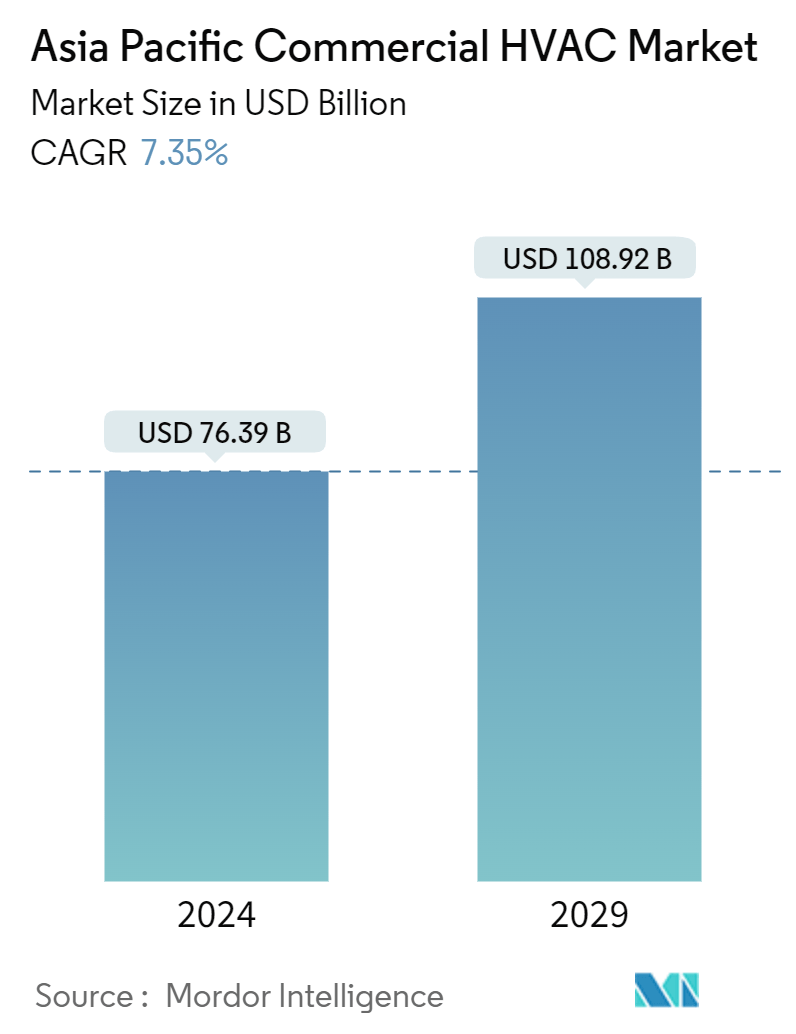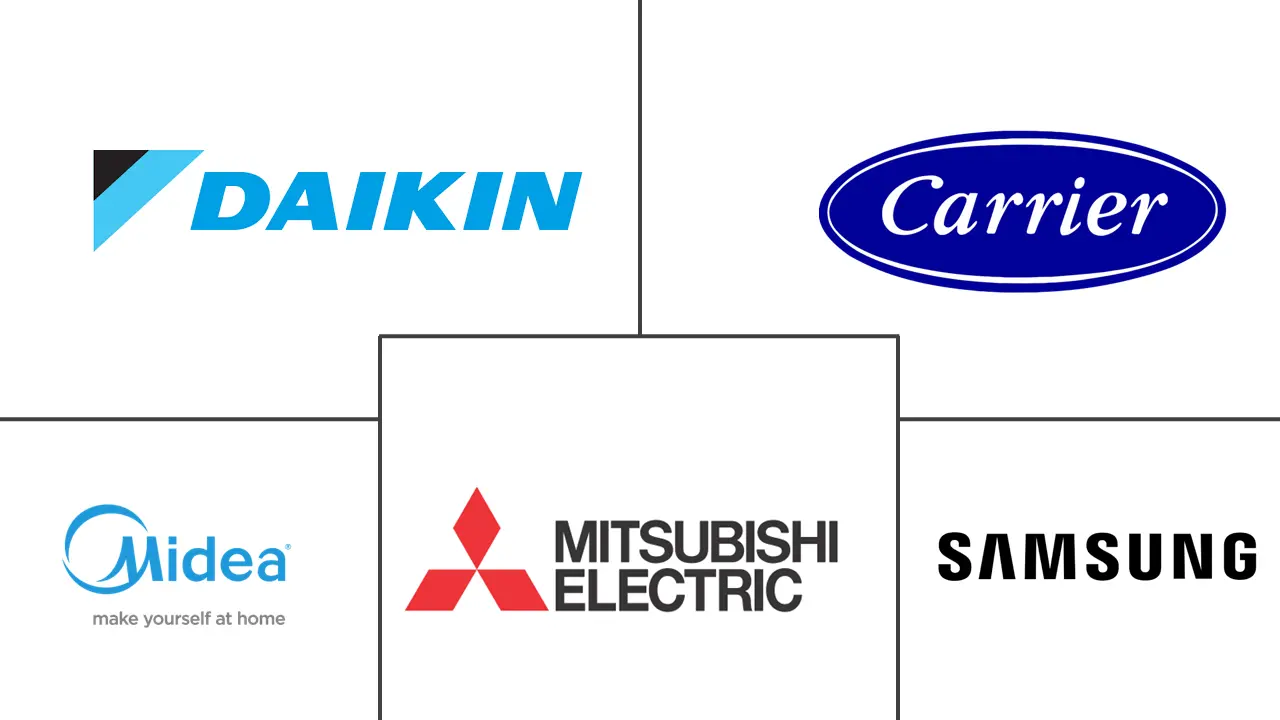Market Size of Asia Pacific Commercial HVAC Industry

| Study Period | 2019 - 2029 |
| Base Year For Estimation | 2023 |
| Market Size (2024) | USD 76.39 Billion |
| Market Size (2029) | USD 108.92 Billion |
| CAGR (2024 - 2029) | 7.35 % |
| Market Concentration | Low |
Major Players
*Disclaimer: Major Players sorted in no particular order |
Asia Pacific Commercial HVAC Market Analysis
The Asia Pacific Commercial HVAC Market size is estimated at USD 76.39 billion in 2024, and is expected to reach USD 108.92 billion by 2029, growing at a CAGR of 7.35% during the forecast period (2024-2029).
- The APAC commercial HVAC market is predicted to rise steadily due to increasing investments in commercial construction activity in developing economies in the region. In addition, the region's strong economic growth, urbanization, and expanding consumer market drive demand for commercial spaces, which is expected to increase the demand for innovative and high-quality HVAC equipment and services.
- Significant drivers of the regional HVAC equipment market's growth in the commercial industry over the forecast period include the surging demand for energy-efficient and sustainable technologies. According to the IEA, electricity consumption in Southeast Asia is expected to double by 2040, with air conditioning systems becoming a significant contributor to overall and peak electricity requirements. The study by the IEA highlights the urgent need to find sustainable solutions for meeting growing energy demand in the region.
- Several regional governments have established rules and regulations in the market that adhere to sustainability and energy efficiency, which expedites technological developments in the market. For instance, in February 2024, Panasonic unveiled its 2024 air conditioner lineup, prominently featuring its range of Matter-enabled room ACs. Matter, a cutting-edge connectivity standard for smart home appliances, facilitates seamless interoperability via brand-agnostic mobile apps. This move positions Panasonic as the pioneer in India, being the first to introduce ACs adhering to this protocol. The brand's launch encompasses a diverse portfolio, with 60 models spanning 1.0-ton, 1.5-ton, and 2.0-ton variants, all equipped with Matter technology.
- The commercial space's heating, ventilation, and air conditioning sectors are changing. The cooling and heating units are smaller, more compact, and more efficient than ever. However, manufacturers and service providers must keep pace with these technological developments. The need for more skilled workers is a significant problem for several regional companies. The HVAC services are often time-consuming and entertaining and need a supervisor to supervise the entire process and closing phase, apart from those installing the necessary equipment. Team management is a real challenge when handling several projects simultaneously.
- The region is home to several HVAC manufacturers and service providers in the commercial segment. They focus on enhancing their market presence by establishing domestic manufacturing facilities to remain competitive. For instance, Japan's Daikin Industries aims to make India a central export hub to nearly triple the Made in India products sold abroad by 2025. Daikin has built a new plant in India, making room air conditioners and compressors a key component. The company will also pursue exports of Made in India aircon products to 100 markets in 2025.
- The conflict between Russia and Ukraine has caused significant problems with regional supply chains. After the COVID-19 pandemic, the region was recovering logistics and supply chains, and this conflict created new market problems. It has contributed to exacerbating existing supply chain problems like commodity exports. On the other hand, Japanese factories are directly affected by the lack of raw materials and components from Ukraine.
Asia Pacific Commercial HVAC Industry Segmentation
Commercial HVAC involves heating and cooling large properties, such as commercial buildings, restaurants, rental properties, hospitals, schools, etc. As a result of the scale, commercial heating and air conditioning differ significantly from their residential counterpart in terms of size, capacity, and operational complexity. The study tracks the revenue accrued through the sale of HVAC by various players in Asia-Pacific. The study also tracks the key market parameters, underlying growth influencers, and major vendors operating in the industry, which supports the market estimations and growth rates over the forecast period. The study further analyses the overall impact of COVID-19 aftereffects and other macroeconomic factors on the market. The report’s scope encompasses market sizing and forecasts for the various market segments.
The Asia-Pacific commercial HVAC market is segmented by type of component (HVAC equipment [heating equipment and air conditioning/ventilation equipment] and HVAC services), end-user industries (hospitality, commercial buildings, public buildings, and other end-user industries), and country (China, India, Japan, and Rest of Asia-Pacific). The report offers market forecasts and size in value (USD) for all the above segments.
| By Type of Component | ||||
| ||||
| HVAC Services |
| By End-user Industry | |
| Hospitality | |
| Commercial Buildings | |
| Public Buildings | |
| Other End-user Industries |
| By Country*** | |
| China | |
| India | |
| Japan |
Asia Pacific Commercial HVAC Market Size Summary
The Asia Pacific commercial HVAC market is poised for significant growth, driven by increasing investments in commercial construction and the region's robust economic expansion. Urbanization and a burgeoning consumer market are fueling the demand for commercial spaces, which in turn boosts the need for advanced HVAC systems. The market is experiencing a shift towards energy-efficient and sustainable technologies, spurred by regulatory frameworks and the urgent need to address rising energy consumption. Innovations such as Panasonic's Matter-enabled air conditioners exemplify the region's commitment to integrating smart and sustainable solutions. However, the industry faces challenges, including a shortage of skilled labor and supply chain disruptions exacerbated by geopolitical tensions and the aftermath of the COVID-19 pandemic.
The competitive landscape of the Asia Pacific commercial HVAC market is characterized by the presence of both global and regional players, all vying to capture market share through strategic initiatives like partnerships and technological advancements. Companies such as Daikin Industries and Carrier Corporation are expanding their manufacturing capabilities and product offerings to meet the growing demand. The market's expansion is further supported by China's push for energy-efficient infrastructure and the opening up of internet data centers, presenting substantial opportunities for HVAC vendors. As the region continues to prioritize sustainable construction and energy management, the commercial HVAC market is expected to thrive, driven by innovations and regulatory support.
Asia Pacific Commercial HVAC Market Size - Table of Contents
-
1. MARKET INSIGHTS
-
1.1 Market Overview
-
1.2 Industry Attractiveness - Porter's Five Forces Analysis
-
1.2.1 Bargaining Power of Suppliers
-
1.2.2 Bargaining Power of Consumers
-
1.2.3 Threat of New Entrants
-
1.2.4 Threat of Substitute Products
-
1.2.5 Intensity of Competitive Rivalry
-
-
1.3 Industry Value Chain Analysis
-
1.4 Impact of COVID-19 Aftereffects and Other Macroeconomic Factors on the Market
-
-
2. MARKET SEGMENTATION
-
2.1 By Type of Component
-
2.1.1 HVAC Equipment
-
2.1.1.1 Heating Equipment
-
2.1.1.2 Air Conditioning/Ventilation Equipment
-
-
2.1.2 HVAC Services
-
-
2.2 By End-user Industry
-
2.2.1 Hospitality
-
2.2.2 Commercial Buildings
-
2.2.3 Public Buildings
-
2.2.4 Other End-user Industries
-
-
2.3 By Country***
-
2.3.1 China
-
2.3.2 India
-
2.3.3 Japan
-
-
Asia Pacific Commercial HVAC Market Size FAQs
How big is the Asia Pacific Commercial HVAC Market?
The Asia Pacific Commercial HVAC Market size is expected to reach USD 76.39 billion in 2024 and grow at a CAGR of 7.35% to reach USD 108.92 billion by 2029.
What is the current Asia Pacific Commercial HVAC Market size?
In 2024, the Asia Pacific Commercial HVAC Market size is expected to reach USD 76.39 billion.

